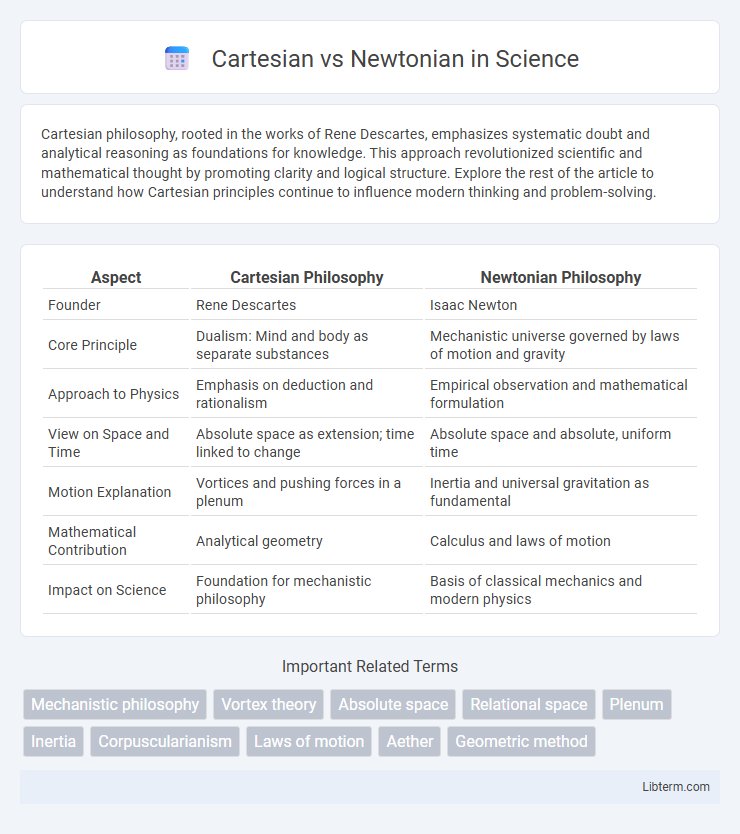Cartesian philosophy, rooted in the works of Rene Descartes, emphasizes systematic doubt and analytical reasoning as foundations for knowledge. This approach revolutionized scientific and mathematical thought by promoting clarity and logical structure. Explore the rest of the article to understand how Cartesian principles continue to influence modern thinking and problem-solving.
Table of Comparison
| Aspect | Cartesian Philosophy | Newtonian Philosophy |
|---|---|---|
| Founder | Rene Descartes | Isaac Newton |
| Core Principle | Dualism: Mind and body as separate substances | Mechanistic universe governed by laws of motion and gravity |
| Approach to Physics | Emphasis on deduction and rationalism | Empirical observation and mathematical formulation |
| View on Space and Time | Absolute space as extension; time linked to change | Absolute space and absolute, uniform time |
| Motion Explanation | Vortices and pushing forces in a plenum | Inertia and universal gravitation as fundamental |
| Mathematical Contribution | Analytical geometry | Calculus and laws of motion |
| Impact on Science | Foundation for mechanistic philosophy | Basis of classical mechanics and modern physics |
Introduction to Cartesian and Newtonian Philosophies
Cartesian philosophy, founded by Rene Descartes, emphasizes rationalism, systematic doubt, and the separation of mind and body, driving the development of modern analytical geometry and scientific method. Newtonian philosophy, based on Isaac Newton's work, centers on empirical observation, mathematical laws of motion, and universal gravitation, forming the foundation of classical mechanics and physics. Both philosophies collectively revolutionized scientific inquiry by combining deductive reasoning with empirical evidence.
Historical Context: Descartes vs Newton
Rene Descartes laid the groundwork for modern physics with his mechanistic view of the universe in the early 17th century, emphasizing a rational, geometrical approach to understanding nature. Isaac Newton, working in the late 17th century, revolutionized scientific thought by formulating the laws of motion and universal gravitation, which provided empirical and mathematical explanations surpassing Cartesian vortex theory. The shift from Cartesian vortex mechanics to Newtonian gravity marked a pivotal transformation in scientific methodology and the conceptualization of physical reality.
Core Principles of Cartesian Mechanics
Cartesian mechanics centers on the principle that all motion arises from vortices in a continuous fluid medium, rejecting the Newtonian concept of empty space and action at a distance. It emphasizes a plenum universe filled with subtle matter, where physical interactions propagate through contact rather than instantaneous forces. This framework contrasts with Newtonian mechanics, which relies on absolute space, time, and gravitational forces acting across a vacuum.
Fundamental Concepts in Newtonian Mechanics
Newtonian mechanics is grounded in the principles of absolute space and time, where forces cause changes in motion described by Newton's three laws of motion. The fundamental concepts include inertia, the relationship between force, mass, and acceleration (F=ma), and action-reaction pairs. Cartesian mechanics, by contrast, often emphasizes fluid-like motion of matter and rejects the notion of vacuum, differing significantly in its conceptual approach to motion and forces.
Key Differences: Cartesian vs Newtonian Views
Cartesian philosophy emphasizes a mechanistic universe governed by clear, distinct ideas and dualism separating mind and body, while Newtonian physics centers on empirical observation and mathematical laws describing motion and gravity. Descartes' approach relies on deductive reasoning from innate ideas, contrasting with Newton's inductive method based on experimentation and calculus. The Cartesian view prioritizes metaphysical certainty, whereas the Newtonian framework revolutionizes scientific understanding through precise measurement and predictive modeling.
Impact on Modern Physics
Cartesian mechanics introduced the concept of continuous matter and vortex theory, influencing early scientific thought but was eventually supplanted by Newtonian mechanics, which provided a mathematically precise framework based on laws of motion and universal gravitation. Newtonian physics laid the foundation for classical mechanics, enabling accurate predictions of planetary motion, inertia, and energy conservation pivotal to technological advancements and engineering. The transition from Cartesian to Newtonian paradigms marked a critical evolution, shaping modern physics by emphasizing empirical measurement, standardized units, and the principle of universal applicability of physical laws.
Influences on Scientific Methodology
Cartesian methodology emphasized deductive reasoning and mathematical rigor, profoundly shaping the development of analytic geometry and formal logic. Newtonian methodology prioritized empirical observation and experimentation, laying the foundation for the modern scientific method through systematic data collection and hypothesis testing. The integration of Cartesian deduction with Newtonian empiricism catalyzed advancements in physics and natural sciences, influencing scientific inquiry frameworks globally.
Philosophical Implications of Each Approach
Cartesian philosophy emphasizes the primacy of reason and doubt, viewing the mind as a separate, immaterial substance distinct from the body, which leads to dualism and challenges in explaining mind-body interaction. Newtonian philosophy grounds knowledge in empirical observation and mathematical laws, promoting a mechanistic and deterministic universe where matter operates under predictable forces. These contrasting approaches raise fundamental questions about the nature of reality, consciousness, and the limits of human knowledge, influencing modern debates in metaphysics and epistemology.
Legacy in Science and Technology
Cartesian philosophy laid foundational principles in analytical geometry and mechanistic views, influencing the development of early calculus and modern computing algorithms. Newtonian physics established universal laws of motion and gravity, directly enabling the advancement of classical mechanics, engineering, and space exploration technologies. The enduring legacy of both systems is evident in their complementary roles: Cartesian methods guide logical problem-solving frameworks, while Newtonian principles power practical applications in physics and astronomy.
Conclusion: Lasting Relevance in Physics
Cartesian mechanics, rooted in Rene Descartes' vortex theory, laid foundational concepts but struggled with empirical validation and complex motion explanations. Newtonian mechanics, established by Isaac Newton's laws of motion and universal gravitation, provided precise predictive power and a robust mathematical framework that remains central to classical physics. The lasting relevance of Newtonian physics lies in its accurate description of macroscopic phenomena and its foundational role in modern scientific and engineering applications.
Cartesian Infographic

 libterm.com
libterm.com